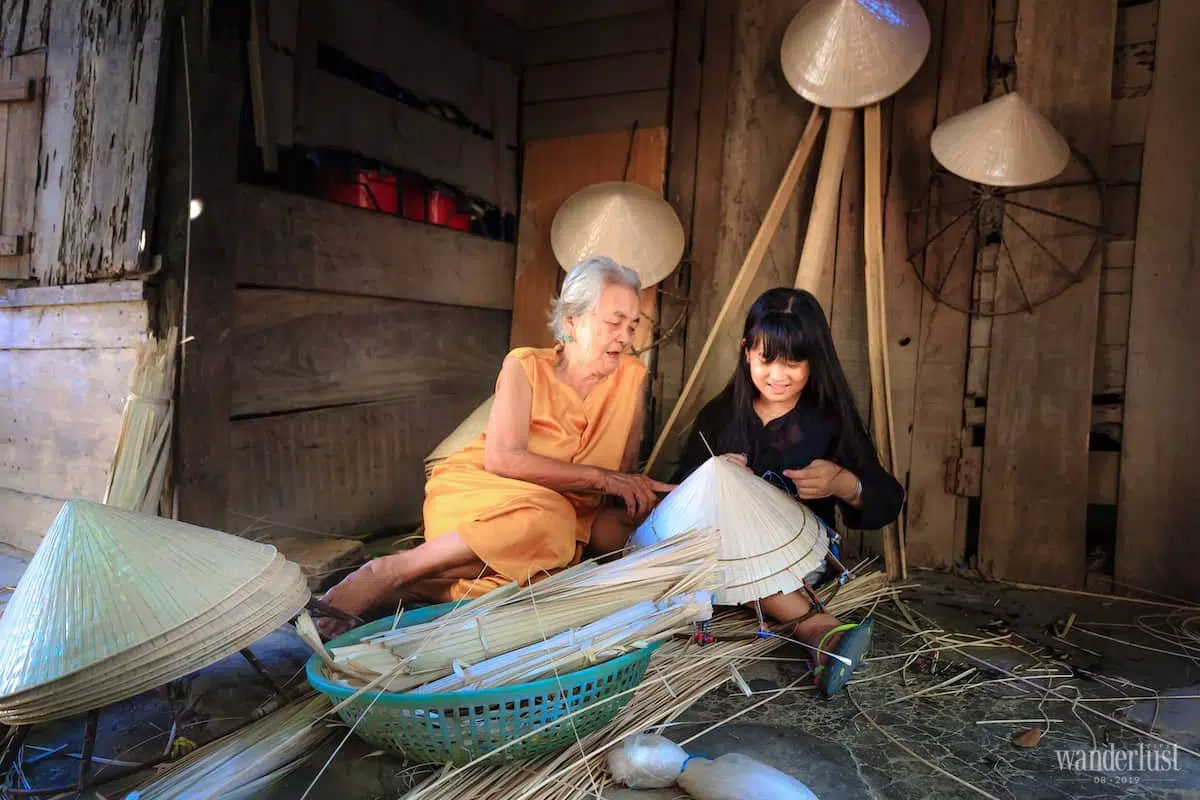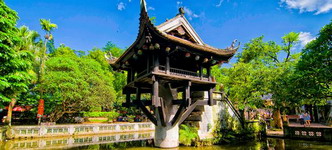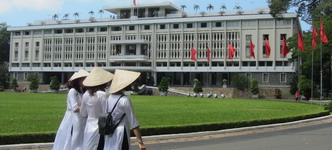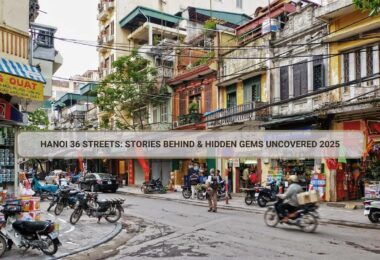Overview:
Chuong village is a famous craft village in the country with a long tradition of making hats through conical hat products. The people of Chuong village live mainly by making conical hats, but agricultural activities are not much because this place is crowded with people. No one in the village knows when the hat appeared, but in the old folk song, there is a sentence that says, “Chung hat, silk ring, Do village strap".
Location:
Chuong Village is located in Phuong Trung commune, 3km from the center of Thanh Oai district, 30km from the center of Hanoi. The total natural area of Chuong village is 481.44 ha, including 8 villages: Tay Son – Chung Chinh – Lien Tan – Quang Trung – Ma Kieu – Tan Tien – Tan Dan 1 and Tan Dan 2. Chuong village has two entrances. The main approach is from Day River dyke to the west of the village boundary and National Highway 21B to the east of the village boundary. The Day River dyke runs through the village an important livelihood route and also functions as a market of a large area not only for Chuong village but also with the participation of some surrounding communes such as Van La. , Kim Thu, Cao Duong. The village dike is also a place where people making conical hats often dry the dead leaves at the raw material processing stage. With the above geographical position, Phuong Trung commune has favorable conditions in the development of commodity production, market access and advanced technology for economic development at high speed.
History:
In the 8th century – 791th year of the New Year, according to the elders in the village, at first, Chuong village was called Trang Thi Trung, later it was more populous, so it was expanded into a village. At the beginning of the Len So dynasty, Chuong village was very crowded.
In the past, Chuong village produced many kinds of hats, used for many classes such as three-level hats for girls, protruding hats, long hats, conical hats, conical hats for boys and luxurious men.
Before the 20th century, the traditional conical hat products of Chuong village were three round conical hats. This is a type of hat that is similar to a sports hat but has three rounds and has a relatively shallow wall. Hats are large in size and for farmers working in the fields, so they are not sewn carefully. The second hat is a basket hat with a very wide brim, tied on both sides for the elderly to wear to the temple.
Previously, the craft of making conical hats developed strongly, the whole village, including young and old, boys and girls, and even children participated in making hats. However, recently, the market for traditional conical conical hats has declined and some households have received orders to produce hats-related products using their knowledge and skills. availability of hat makers in the village. Chuong Village both manufactures and supplies speaking products to serve other creative products (hat sports straps, colorful silk hats), souvenirs (hats of different sizes and colors), interior decoration (lights). conical cages, wall hangings in restaurants, refreshment bars, furniture such as tea tables, etc., and street decoration (decorating the landscape of pedestrian streets in Hanoi).
Process to make conical hat:
Stage 1:
The hat is an indispensable part of the hat. With the Bell hat, there will be 16 rings on the inside of the hat. In the past, the hat was made by Chuong village, but now it is made by the two villages of Don Thu and Trang Xuan and brought to the market for sale on every occasion. The sixteen hoops are classified into: 1-strand waistbands, 4-strand anklets (circles), 5-strand cork loops (slanted loops), 5-thread crochet loops (slanted loops), and 1-strand hoops. These rings must be sharpened evenly to create a beautiful hat. The work of making hats requires both strength and dexterity of the hands.
Glancing is also an important part of making a strong and beautiful hat. The palm tree, also known as the cottonwood tree, was bought and sold by the people of Luu Thuong village, Phu Tuc commune, Phu Xuyen district. The gut is a gutter – what is used to connect the two ends of the brim and keep the brim round and durable.
The raw material for stitching hats is wire, there are many types: big red yarn is often used to sew hat brim, small white wire is used to sew hat loops. Before people used to use hooks and pineapples to sew hats. But by the 80s of the 20th century, the villagers used freight because its outstanding advantages were not only to help people sew faster, but also to enhance the beauty of the conical hat. Next to the freight, there is a thread of thread. This yarn is made of lace bought from Trieu Khuc village and used to embroider both sides of the hat to make the two ends of the hat straps to help hold the hat more firmly. There are paper drawings to decorate the inside of the Bell hats.
Stage 2:
In general, the current production process of conical hats in Chuong village has not changed much compared to the traditional production process for many generations in terms of implementation principle. There are only some more modern changes related to materials to support more convenient handling such as cone stitching materials (thread, thread, needle), hat decoration material (glossy oil, thread, etc.) protruding to tie the hat straps)…
Chuong conical hat market:
Chuong market is a large market in the region, not only Chuong villagers go to the market but also share with some neighboring communes such as Van La, Cao Duong, and Kim Thu. The market has main sessions on the 4th, 10th, 14th, 20th, 24th, 30th and the secondary sessions on the 1st, 3rd, 6th, 8th, 11th and 13th. The Chuong village fair held on the tenth day of the first month is the festival. the largest market of the old Ha Dong province.
Chuong market is actually a festival of agricultural cultural activities of a land. The craft village culture is also on this occasion expressed in the fair day.
Communal house in Chuong village:
Chuong village has a number of family lines that make up the majority and long-standing in the village are Pham family, Le family, Hoan family. Like many other traditional villages, the residence of the villages in the village is based on kinship ties. The survey team recorded two churches with the Le Dinh family in Chung Chinh village and the Pham family in Tay Son village.
Foods in Chuong village:
Chuong village has delicious rolls famous in the region. According to Ms. Pham Thi Dung, vice chairwoman of Phuong Trung Commune Women’s Union, Chuong village’s roll cake is loved by many people inside and outside the village as well as tourists. In addition, at Chuong market, there is also a peanut cake dish that is also sold regularly in the market and is a rustic dish associated with the farmer’s life.
Tours:







































